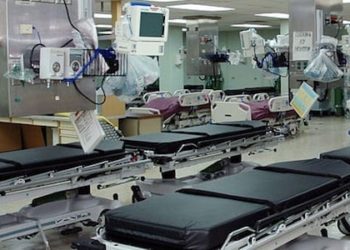Balanced-multi-electrolyte-solution does not reduce risk of death among intensive care patients
1. Patients in the intensive care unit receiving balanced multi-electrolyte solution (BMES) did not have a reduced risk of death compared to patients receiving saline.
2. Intensive care unit patients receiving BMES were not shown to have a reduction in kidney injury compared to patients receiving saline.
Evidence Rating Level: 1 (Excellent)
Study Rundown: While 0.9% sodium chloride solution (saline) is the most universally used intravenous fluid used across intensive care units (ICU), there are concerns that saline injury causes acute kidney injury and increases the risk of death. Consequently, balanced multi-electrolyte solutions (BMES) have been alternatively used. To explore whether BMES improves ICU patient outcomes, this randomized controlled clinical trial utilized either Plasma-Lyte 148, a BMES, or saline over the course of the patient’s stay in intensive care. The primary objective of this study was to investigate the mortality rate within 90 days after randomization. Secondary outcomes measured peak increases in creatinine levels, receipt of renal-replacement therapy, and duration of ICU stay. The results of this study found no significant differences between the two groups for mortality rate within 90 days, rate of initiation of renal-replacement therapy, maximal increases in creatinine levels, nor in the number of adverse events. Overall, this study demonstrates no added benefit or harm in using BMES instead of saline for intensive care patients. The results of this study were limited by smaller sample size than intended, and a lack of primary outcome data on a subset of patients. Moreover, the volume of BMES or saline administered was not accounted for.
Click to read the study in NEJM
Relevant Reading: Clinical effects of balanced crystalloids vs saline in adults with diabetic ketoacidosis: a subgroup analysis of cluster randomized clinical trials
In-Depth [randomized controlled trial]: In this double-blind, parallel-group, open-label randomized controlled trial across 53 intensive care units (ICU) in Australia and New Zealand, 5037 patients in intensive care with a necessity for fluid resuscitation were randomized using permuted blocks to either receive Plasma-Lyte 148 balanced multi-electrolyte solution (BMES) or 0.9% sodium chloride solution (saline). Patients were excluded if they had specific fluid requirements, had already received fluid resuscitation, or were not expected to have a good prognosis. The primary outcome of the study was to assess the mortality rate due to any cause within 90 days post-randomization. This was analyzed within six subgroups according to demographic factors and severity of illness. For secondary outcomes, the study measured peak serum creatinine, a necessity for renal-replacement therapy, and duration of ICU stay. The study found that after 90 days, 21.8% of patients in the BMES had died compared to 22.0% in the saline group (OR: 0.99, 95%CI [0.86-1.14]; P=0.90). No differences were found even after adjusting for demographic and severity of disease factors or excluding patients receiving more than 500mL of fluid. Similar levels of maximum serum creatinine level and reception of renal-replacement therapy were also found between groups. The number of total and severe adverse events also did not significantly differ. Altogether, there is no data to support differences in mortality rate or incidence of acute kidney injury between intensive care patients receiving BMES compared to saline. The type of fluid resuscitation used should be selected according to specific patient characteristics.
Image: PD
©2022 2 Minute Medicine, Inc. All rights reserved. No works may be reproduced without expressed written consent from 2 Minute Medicine, Inc. Inquire about licensing here. No article should be construed as medical advice and is not intended as such by the authors or by 2 Minute Medicine, Inc.









